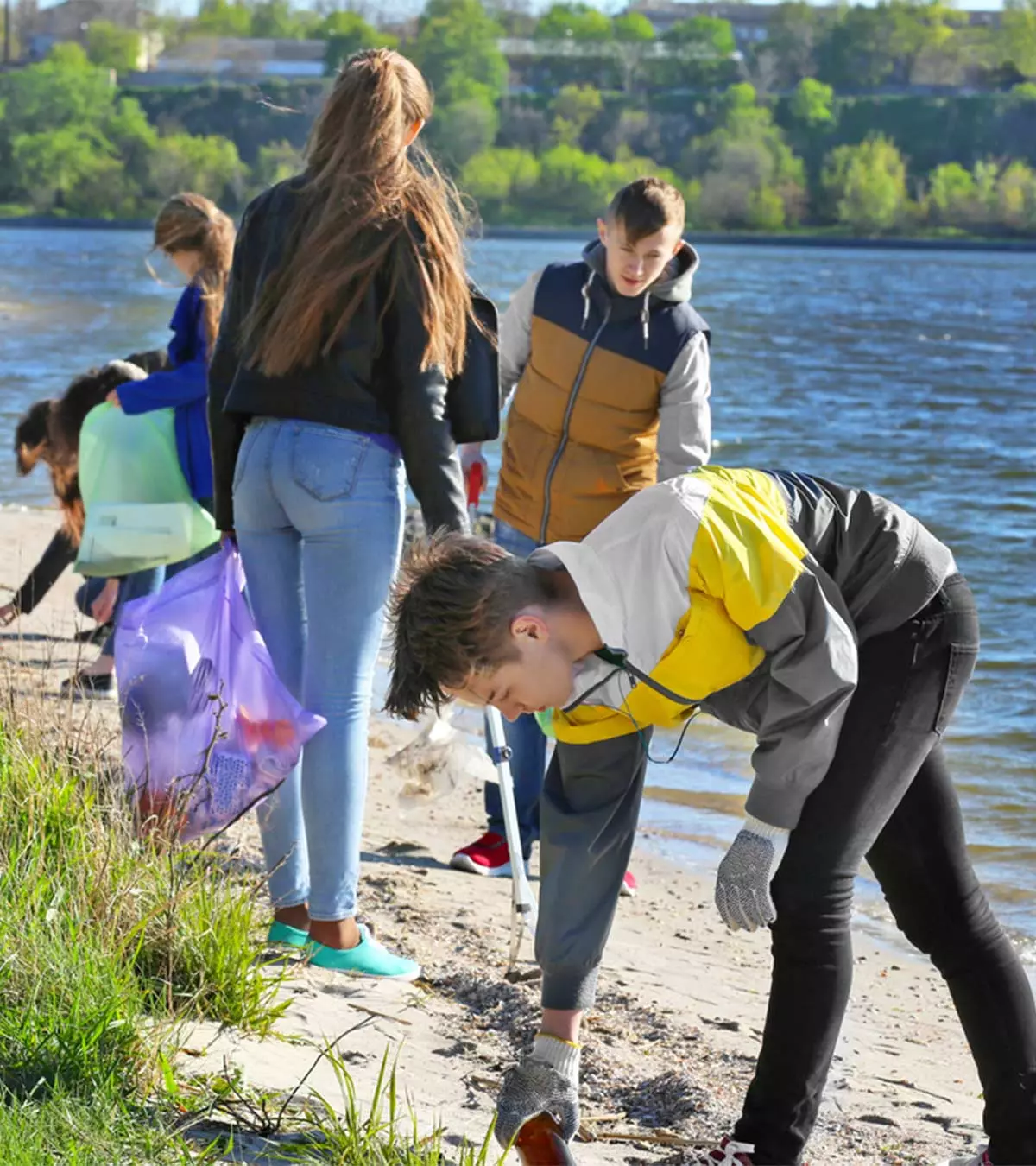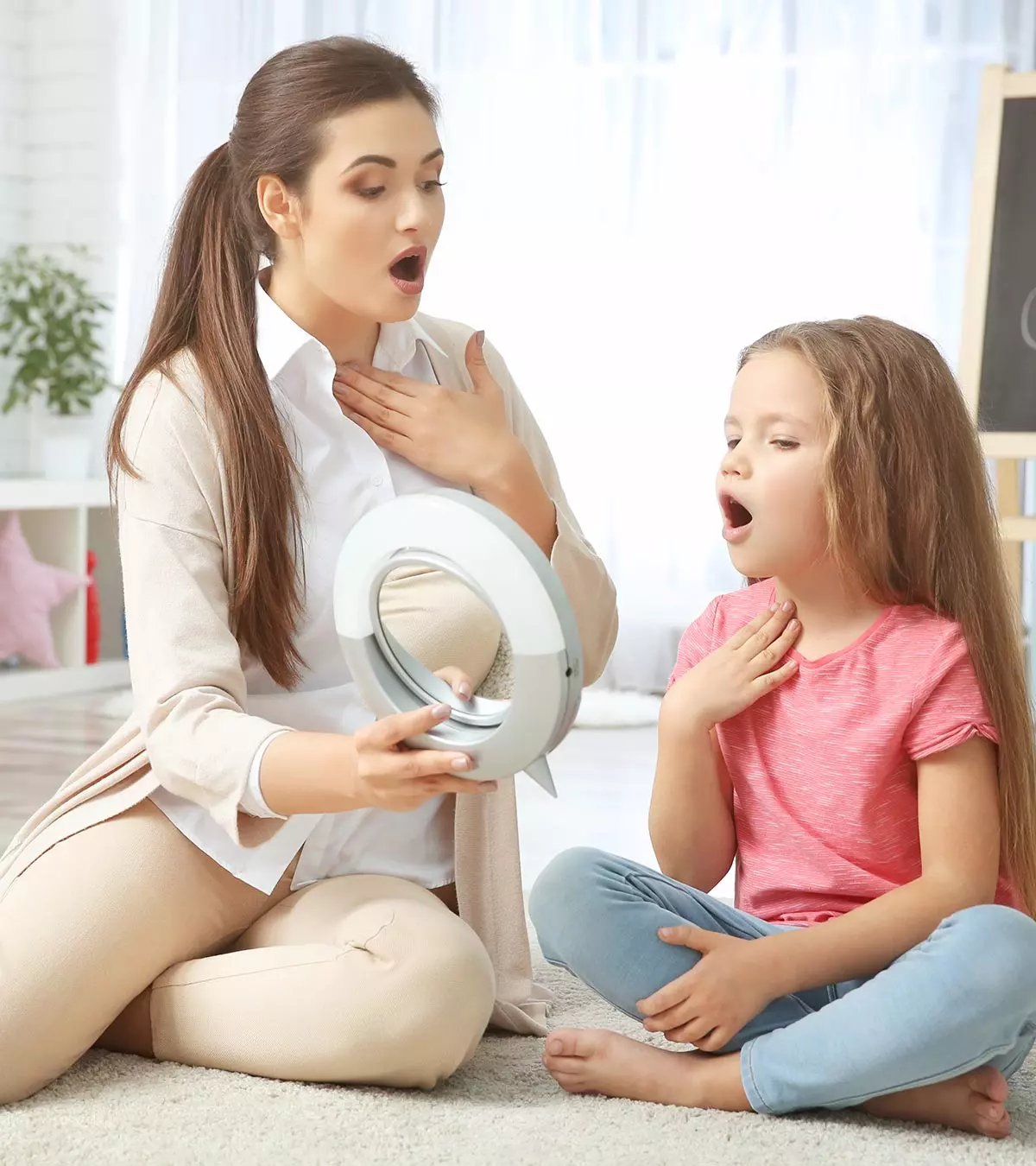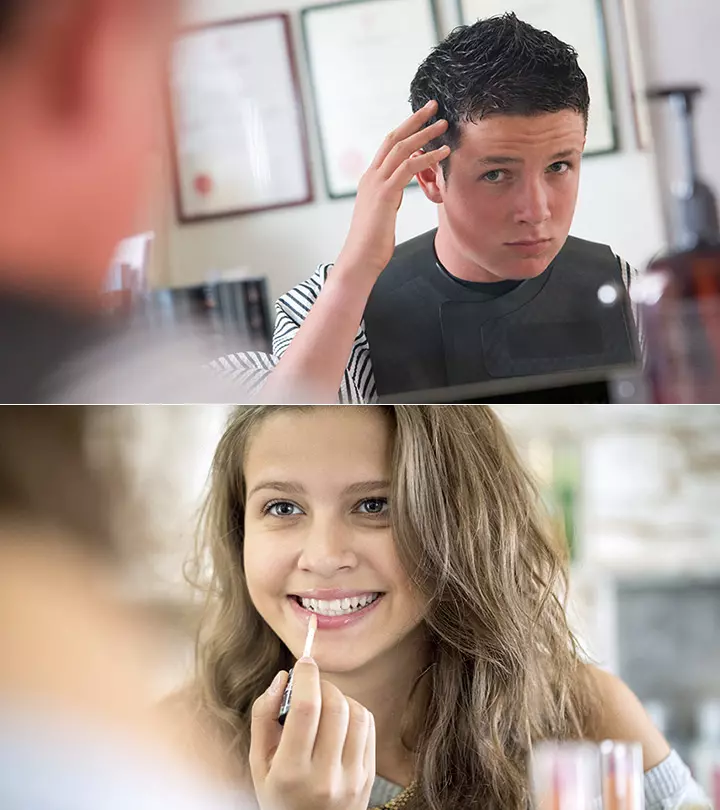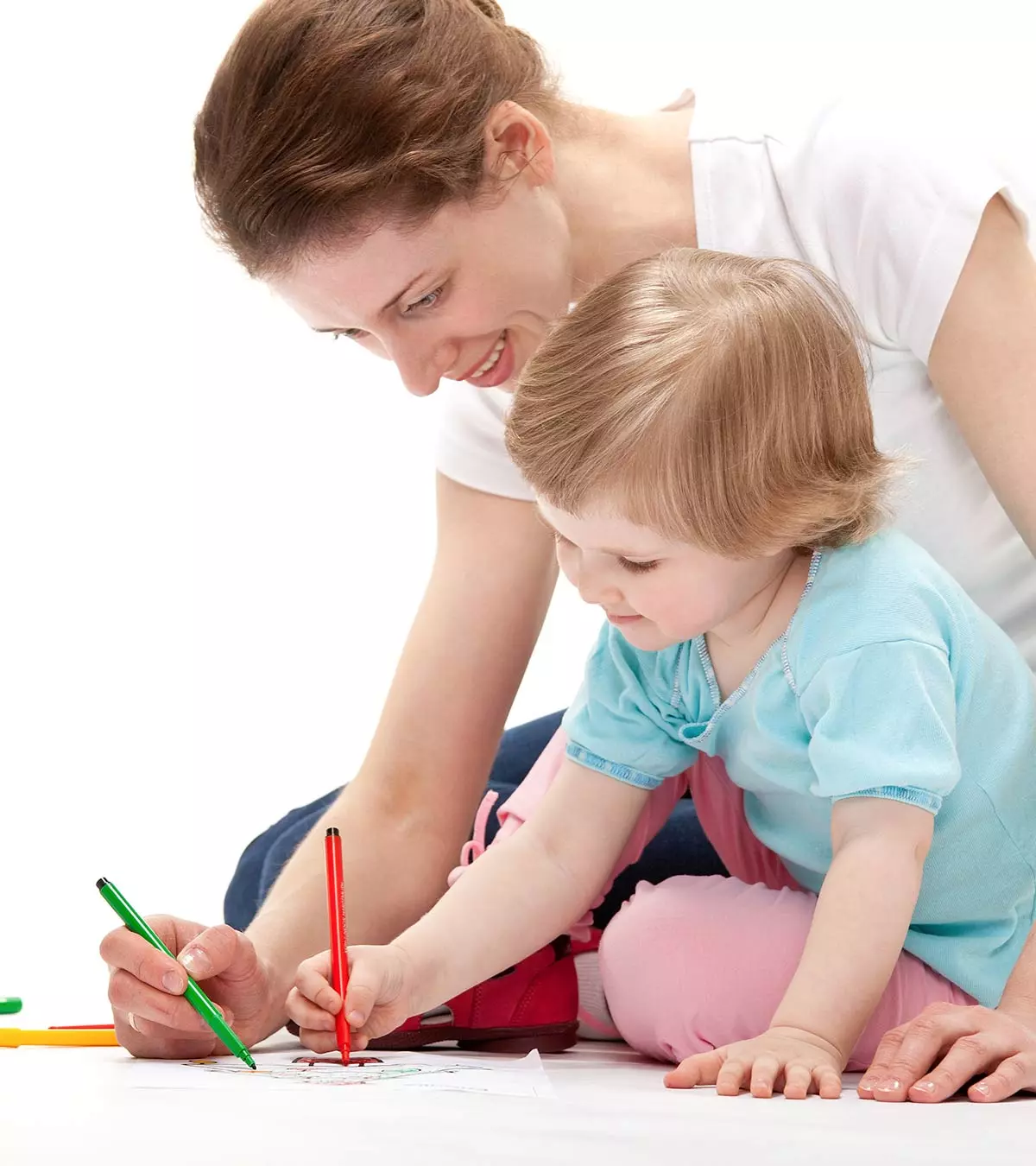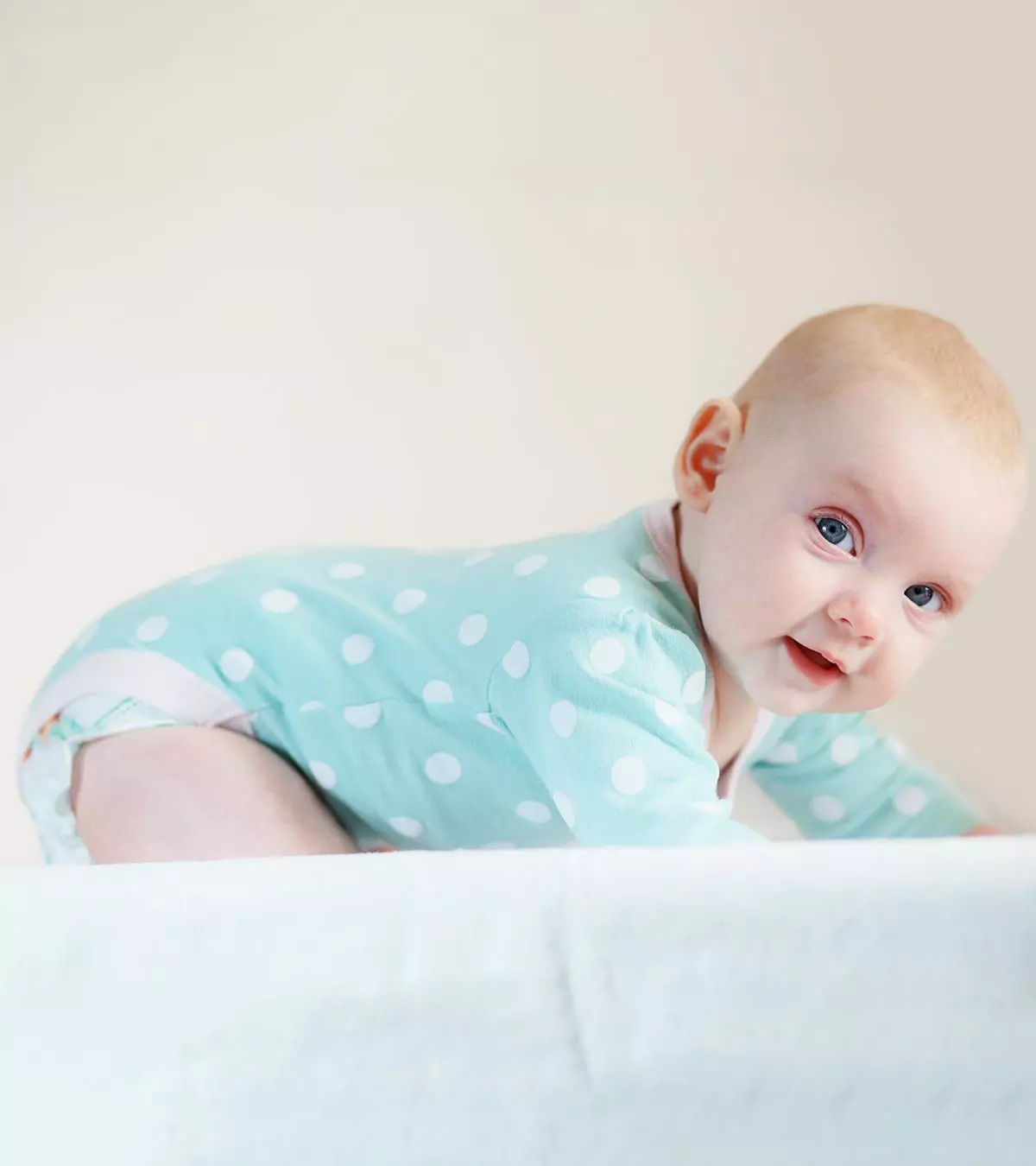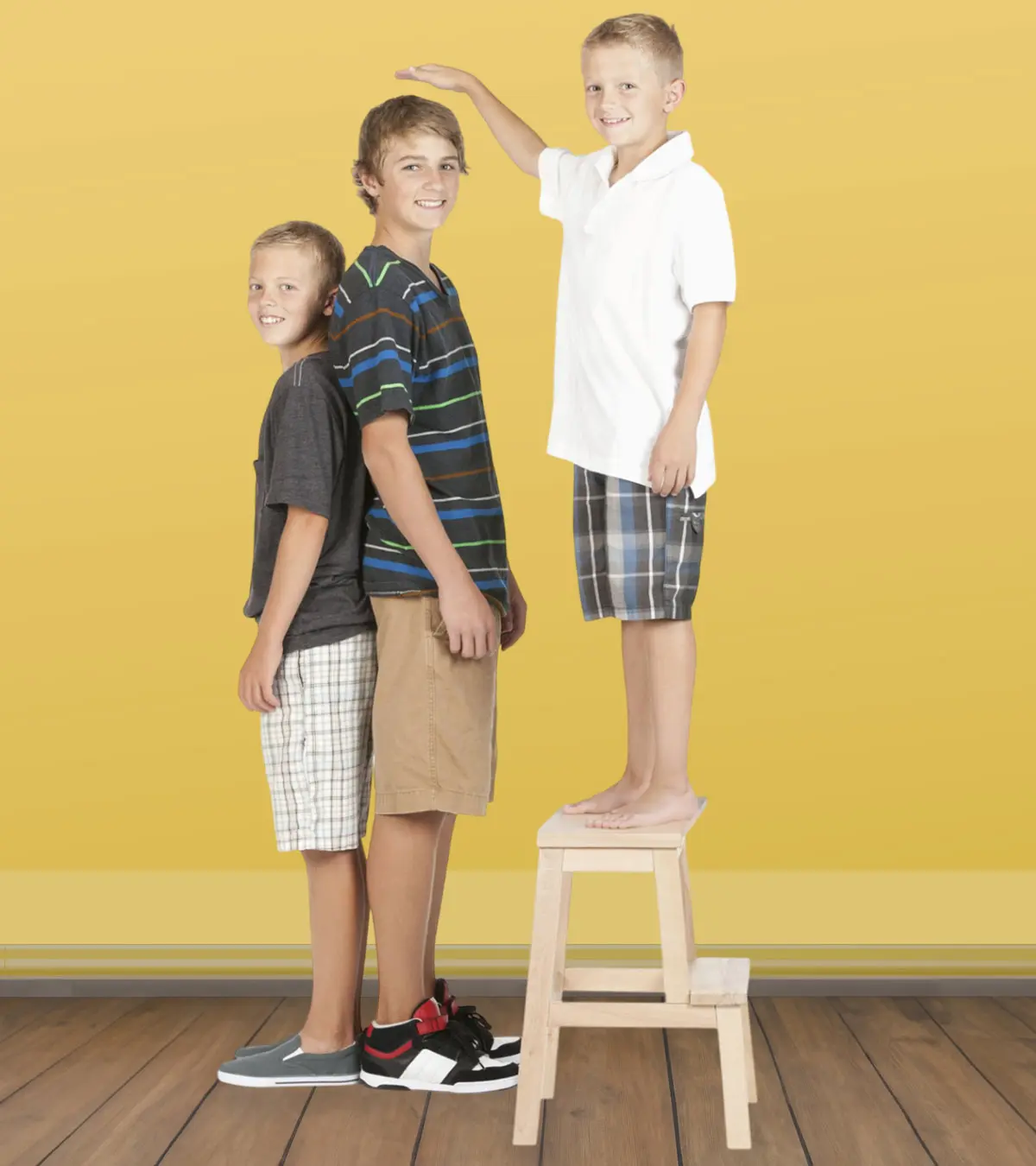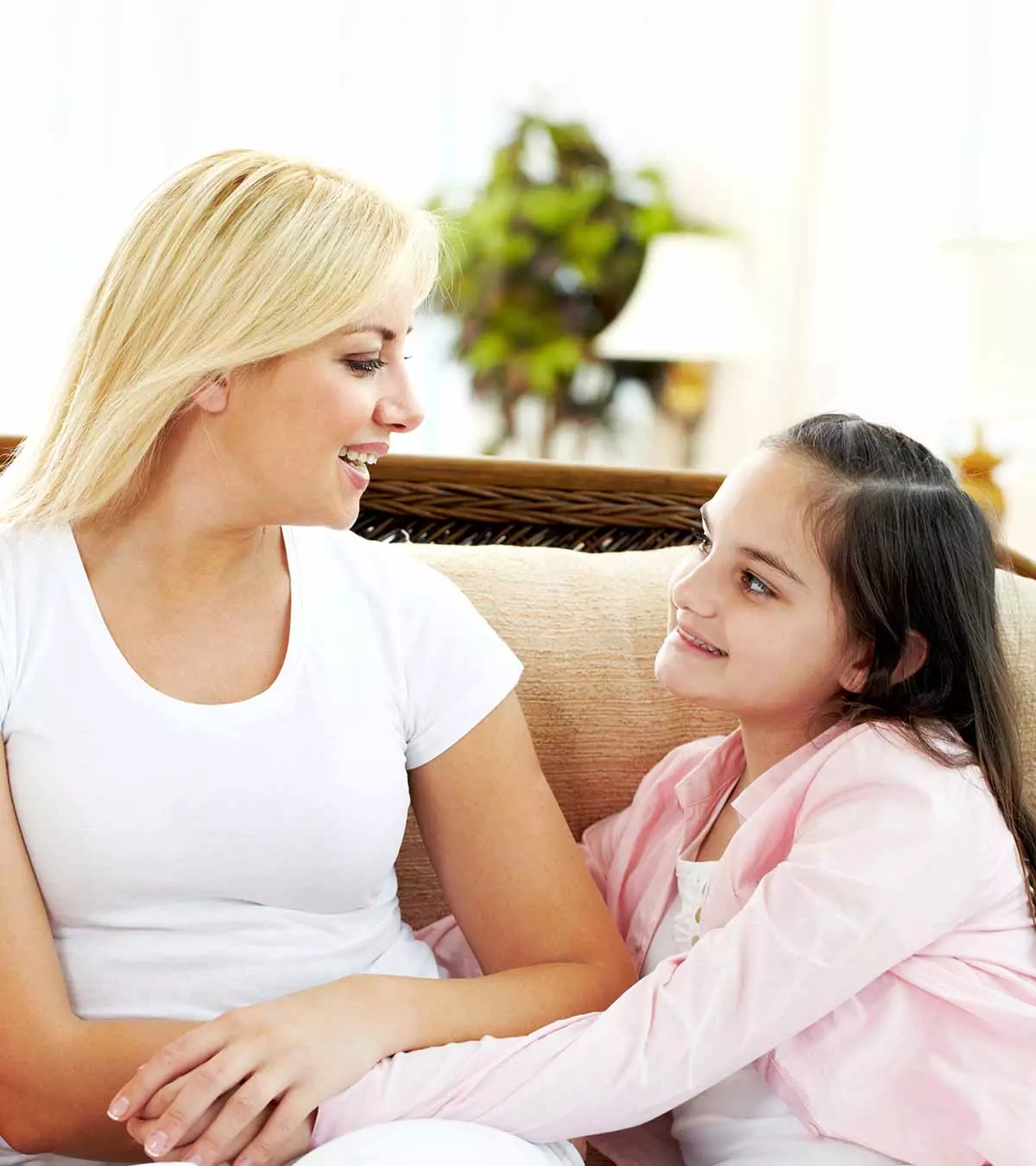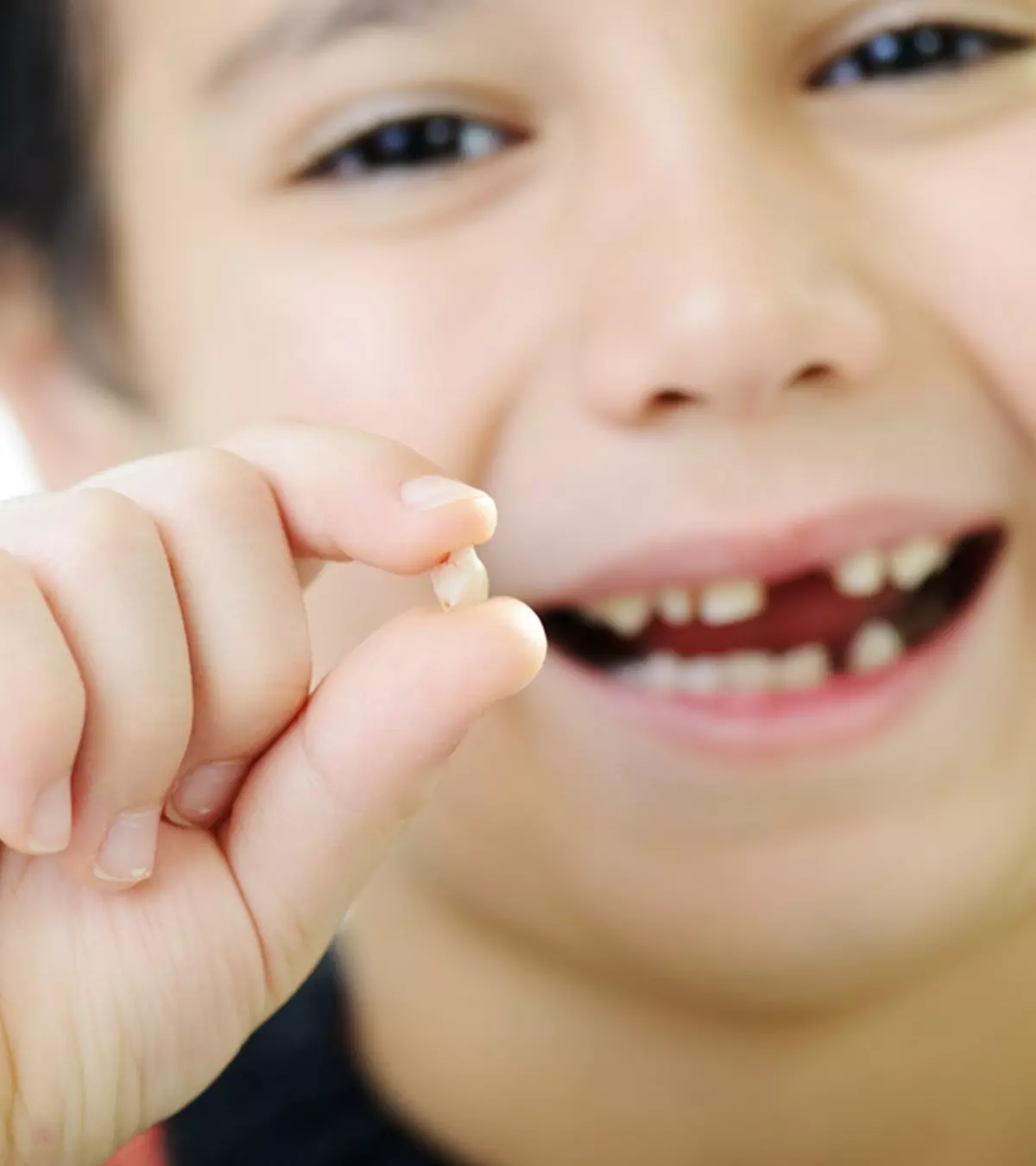
Image: ShutterStock

Parenting is all about experiencing and appreciating the different milestones in your child’s life. Teething is one such milestone, and after a few years, children’s primary or baby teeth give way to permanent teeth. So when do kids start losing teeth?
This process may occur before time for some children, while it may get delayed in others. When children start losing their baby teeth, parents are often concerned about potential problems.
Read this post to answer some common questions regarding children losing their baby teeth and to understand what to expect.
Key Pointers
- Children tend to start losing their primary or milk teeth by six years.
- If your child feels discomfort due to a loose tooth, try pulling it out with a gauze or tissue.
- After losing a tooth, wash your child’s mouth properly with water and use a damp towel to stop the bleeding.
- If they experience pain after a tooth has fallen out, visit the dentist.
When Do Babies’ Teeth Develop?
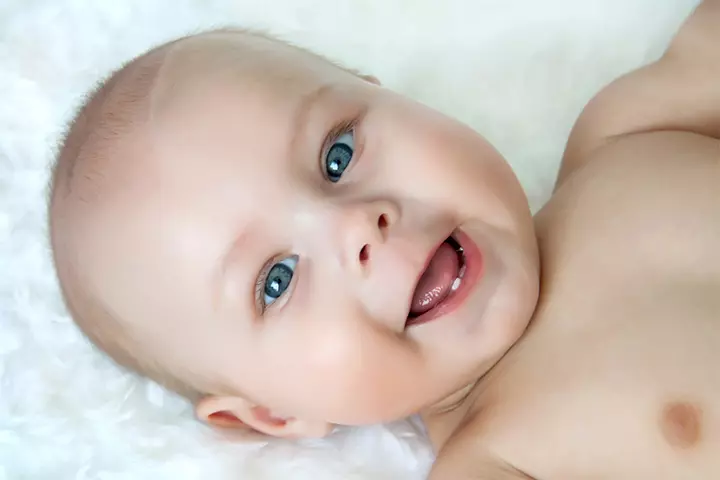
Most babies develop primary teeth, also known as milk teeth or baby teeth, during infancy, which is between four and twelve months. This period often brings discomfort, as baby teething can make infants fussy and restless. However, teeth development begins during the gestation period itself. Thus, mothers are advised to eat healthily and avoid certain medicines, such as tetracyclineiAntibiotic medicine used to treat infection caused by bacteria. , to ensure the fetus’s healthy teeth development (1).
At six weeks of gestation, the tooth’s basic substance is formed, and by three to four months of gestation, the hard tissue surrounding the teeth gets formed. The next stage, known as eruption, occurs when the primary or baby teeth protrude through the gum after the child is born (1).
The first tooth generally appears or erupts by the age of six months, and by the age of three years, toddlers have a set of 20 primary teeth. However, as every child is different, the first tooth may erupt as early as four months in some children. These primary teeth are shed throughout childhood (1) (2).
When Do Children Start Losing Teeth?
John Funk, a preschool teacher and former president of the Utah AEYC, recounts the moment when his granddaughter lost her first baby tooth. He shares, “My granddaughter lost her first baby tooth this past week. Such a growing-up milestone! When your my age, losing a tooth would be a growing-OLD milestone. Not one that I want to experience anytime soon. The new lost tooth, however, does represent a growth process in the physical development of a young child (i).”

The first set of teeth, also known as deciduous teeth, are replaced by permanent teeth. When a permanent tooth erupts, it causes resorptioniInflammation and loss of tooth tissue. of the root of the primary teeth. This leads to loosening, and the baby’s tooth is held only by a small amount of tissue (3).
Usually, children start losing their primary teeth at around six years of age. The central incisors (the middle teeth in the front) are the first ones to be replaced by permanent incisors. By the age of 10 to 13 years, all baby teeth are shed and replaced by permanent teeth and by the age of 21, all 32 permanent or adult teeth erupt (1) (2) (3).
How Many Baby Teeth Do Children Lose?

Between six and 13 years of age, children lose all 20 primary teeth to be replaced by permanent teeth. Specific developmental differences can also determine how many teeth will develop. When babies lose their teeth due to accident or decay, permanent may teeth erupt prematurely. This may lead to crooked teeth due to limited space (1). Hence, it is essential to maintain good dental hygiene. Make them the habit of using toothbrush and toothpaste right from a young age. Also ensure your child does not forget to brush and floss their teeth regularly. Also, ensure to take your child for dental check-ups at the orthodontist at regular intervals.
 Point to consider
Point to considerTimeline For Tooth Eruption And Shedding
The average timeline for eruption and shedding of baby teeth is as follows (2).
| Teeth position | Eruption | Shedding |
| Baby teeth | ||
| Lower central incisor | 6–10 months | 6–7 years |
| Lower lateral incisor | 10–16 months | 7–8 years |
| Lower canine (cuspid) | 17–23 months | 9–12 years |
| Lower first molar | 14–18 months | 9–11 years |
| Lower second molar | 23–31 months | 10–12 years |
| Upper central incisor | 8–12 months | 6–7 years |
| Upper lateral incisor | 9–13 months | 7–8 years |
| Upper canine (cuspid) | 16–22 months | 10–12 years |
| Upper first molar | 13–19 months | 9–11 years |
| Upper second molar | 25–33 months | 10–12 years |
How To Get Loose Teeth Out?
In anticipation of the tooth fairy, children may try to poke and pull out the loose tooth with a finger or tongue. They may also wish to pull it out as it can cause discomfort. If your child insists on pulling out the loose tooth, you can try these options (3).
- Hold the loose tooth with the help of a gauze or a tissue and twist it quickly to pull it out. Do not pull it out just because it makes the child uncomfortable. Sometimes, from becoming loose to dropping out, tooth shedding can take a few weeks to months.
- If a primary tooth does not loosen on its own even after your child has crossed the age of 13, take your child to a dentist for tooth extraction.
 Quick tip
Quick tipWhat To Do After A Child Loses A Tooth?

Here are a few things you could do after your child loses a baby tooth.
- It is always a good idea to have a chat with your child about teeth and oral hygiene. It soothes the nerves and helps keep them calm in case of slight bleeding, tingling sensation, or pain.
- Inform them beforehand that the sensation and bleeding would be minor and end after some time.
- After the tooth falls, make the child rinse the mouth and hold a damp towel over it for a few minutes to stop the bleeding.
- In case of pain, use a doctor-recommended oral analgesiciA medicine used to relieve pain. and watch for an hour. If the pain and bleeding persist, take the child to the dentist.
Remember that a dental appointment is not an indication of a problem.
The American Academy of Pediatrics (AAP) and the American Academy of Pediatric Dentistry (AAPD) recommend that all children by the age of one see a pediatric dentist and have a “dental home” (4). After the eruption of the first primary tooth, and by their first birthday, take the child to a pediatric dentist. The dentist will check for any dental issues and offer you oral hygiene tips.
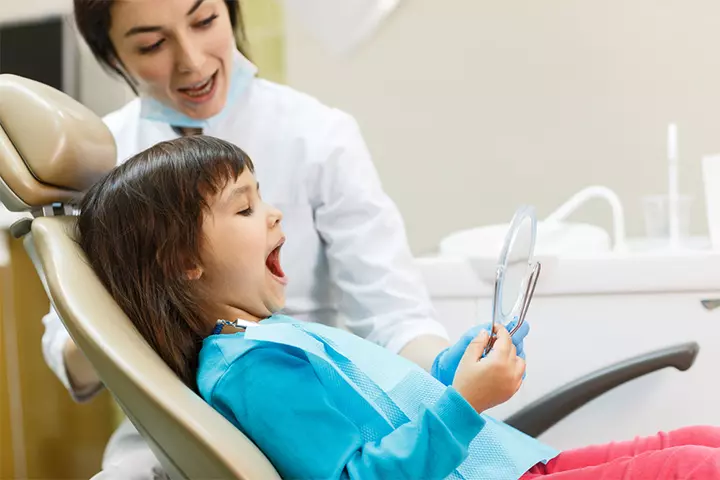
Why Do We Have Two Sets Of Teeth?
We have two sets of teeth in our lifetime — 20 baby teeth and 32 permanent teeth. Baby teeth not only help children eat but also act as placeholders and create appropriate space for the eruption of permanent teeth.
When a permanent tooth erupts, the root of the baby tooth is dissolved. This causes the tooth to become wiggly, and it is only held by the surrounding gum tissue. When the baby tooth is shed, the adult tooth takes its place.
All baby teeth are not shed at once but gradually. This process is essential to maintain the jaw shape and facilitate chewing, biting, and speaking.
Frequently Asked Questions
1. Is it normal for a four-year-old to lose teeth?
Children may start to lose their teeth around the age of six years. As per a case study published in the National Library of Medicine, early teeth loss in children could indicate hypophosphatasia, an inherited disorder that disrupts the mineralization of bones and teeth (5). The signs of hypophosphatasia may differ in each child. Bowed legs, short stature, frequent mild diseases, and rickets are some other symptoms of hypophosphatasia. If you notice any signs of hypophosphatasia, consult a doctor for diagnosis (6).
2. What happens if the baby’s teeth don’t fall out?
Late falling of early teeth may hinder the growth space of the adjacent permanent teeth. These baby teeth may also hinder the growth of the permanent teeth beneath them, thus causing the permanent ones to grow crooked.
3. What can children eat after losing a tooth?
Give your child plenty of fruits and vegetables after a tooth loss. The fiber in fruits and vegetables helps clean the gums and teeth. Also, include milk and milk products in their diet as calcium and phosphorus promote healthy teeth growth (6). Make sure they don’t chew from the side where the tooth was extracted.
Children losing their milk teeth is an important milestone for every child and parent. You may wonder when do kids start losing teeth if their bunny-like tiny teeth start appearing. Baby teeth, also known as milk teeth, begin to fall out around the age of six and continue until they are replaced by a permanent set of teeth by 12. Because the baby teeth help to create space and adequate conditions for the permanent teeth, it is essential that you take proper care of your child’s oral health from the beginning. Therefore consult your child’s dentist and take the necessary measures to maintain proper oral hygiene and prevent early teeth loss or eruption and tooth decay.
Infographic: What To Discuss With Children When They Lose A Tooth?
Children lose all their primary teeth, which are replaced by permanent teeth by 13 years of age. While losing teeth is a natural process, there are some things that you must inform your child about when they lose teeth. The infographic below explains some of those essential points.
Some thing wrong with infographic shortcode. please verify shortcode syntaxIllustration: When Do Kids Start Losing Teeth? Age Complications & More

Image: Dall·E/MomJunction Design Team
My child is losing teeth – but what age should this be happening? Find out in this video!
Personal Experience: Source
MomJunction articles include first-hand experiences to provide you with better insights through real-life narratives. Here are the sources of personal accounts referenced in this article.
i. Lost teeth;https://eceducationblog.wordpress.com/2006/09/27/lost-teeth/
References
1. Anatomy and development of the mouth and teeth; Children’s Wisconsin
2. Eruption Charts; American Dental Association
3. When Children Begin to Lose their Baby Teeth; American Academy of Pediatrics
4. Baby’s First Tooth: 7 Facts Parents Should Know; American Academy of Pediatrics
5. Sara L Hughes et al; Early Tooth Loss in Children: A Warning Sign of Childhood Hypophosphatasia; National Library of Medicine.
6. Hypophosphatasia; National Organization for Rare Disorders.
7. The Health and Worst Foods for Your Teeth; University of Rochester Medical Center.
8. A Child’s First Dental Visit Fact Sheet; Stanford Medicine.
9. When Children Begin to Lose their Baby Teeth; American Academy of Pediatrics
Community Experiences
Join the conversation and become a part of our nurturing community! Share your stories, experiences, and insights to connect with fellow parents.
Read full bio of Dr. Tazeen Raees
Read full bio of Dr. Ritika Shah
Read full bio of Harshita Makvana
Read full bio of Shinta Liz Sunny






